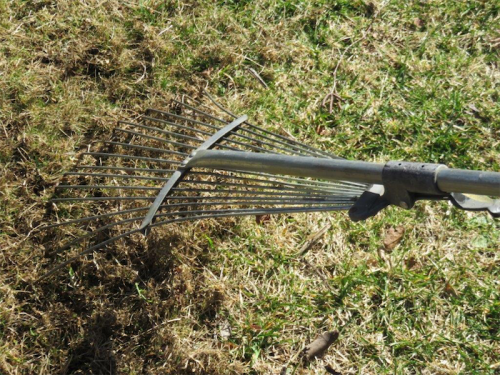
LAWNS look understandably sad at present with little or no rain and severe frosts.

But will the lawn recover? As in the bush with the severe drought, the grass is still there and with good rains will come again, it will not be dead.
As the days warm and surely they will very soon, the grass will quickly green up. This is where we gardeners can help nature along. One of the first tasks is scarifying, coring or dethatching the lawn, followed by a good feed.
A lawn’s spring recovery will depend to a certain extent on the type of grass. Ours has been patched with a variety of seeds and, despite this, will look reasonably good again.
If a lawn is in reasonable shape scarifying is the easiest method, mainly to remove any dead grass. I use a metal spring tine rake, as illustrated, that adjusts from 25cm to 60cm wide simply by sliding a lever on the handle. I find the halfway mark ideal to remove dead grass including, in my case, runners of couch grass.
It is also great for raking leaves in awkward spots in garden beds just by adjusting the width. One very important point, don’t be tempted to put the rakings on the compost heap. They can contain runners of couch and maybe other weeds. I put the rakings into our trash pack.
If the lawn has been neglected for some time the turf may be matted. The answer is dethatching with a machine fitted with a number of tines, set like a series of vertical lawn-mower blades. This has the effect of cutting up the tufts and allowing new roots to develop. Again, beware of weeds in the raked excess grass.

But for heavily compacted lawns the answer is coring. Imagine a line of apple corers mounted on a machine rapidly digging into the soil. This process aerates the soil, allowing for improved water penetration.
However, if the ground has become very compacted, the addition of a liquid ground breaker is advisable to soak into the core holes to increase water penetration to the roots.
Late August to the end of September is the time to feed a lawn, followed by an additional feed six to eight weeks later. I suggest certified organic Neutrog Seamungus pellets, a combination of seaweed and chook poo.
One word of warning, coring or dethatching machines are extremely heavy and take some negotiating, especially in small spaces. The cost of hiring and getting them on and off a trailer is a challenge in itself. Over the years I have heard of dramatic stories of out-of-control coring machines plowing through garden beds! I recommend, except for rake scarifying, using a professional lawn person to carry out this work.
Jottings…
- Feed all daphne plants now to encourage late-winter flowering.
- Lightly prune camellia sasanqua as buds will shortly start to form for next year’s flowers. Apply a certified organic fertiliser.
- Remember, if veggie seedlings are in stock at garden centres it’s time to plant.
Who can be trusted?
In a world of spin and confusion, there’s never been a more important time to support independent journalism in Canberra.
If you trust our work online and want to enforce the power of independent voices, I invite you to make a small contribution.
Every dollar of support is invested back into our journalism to help keep citynews.com.au strong and free.
Thank you,
Ian Meikle, editor




Leave a Reply